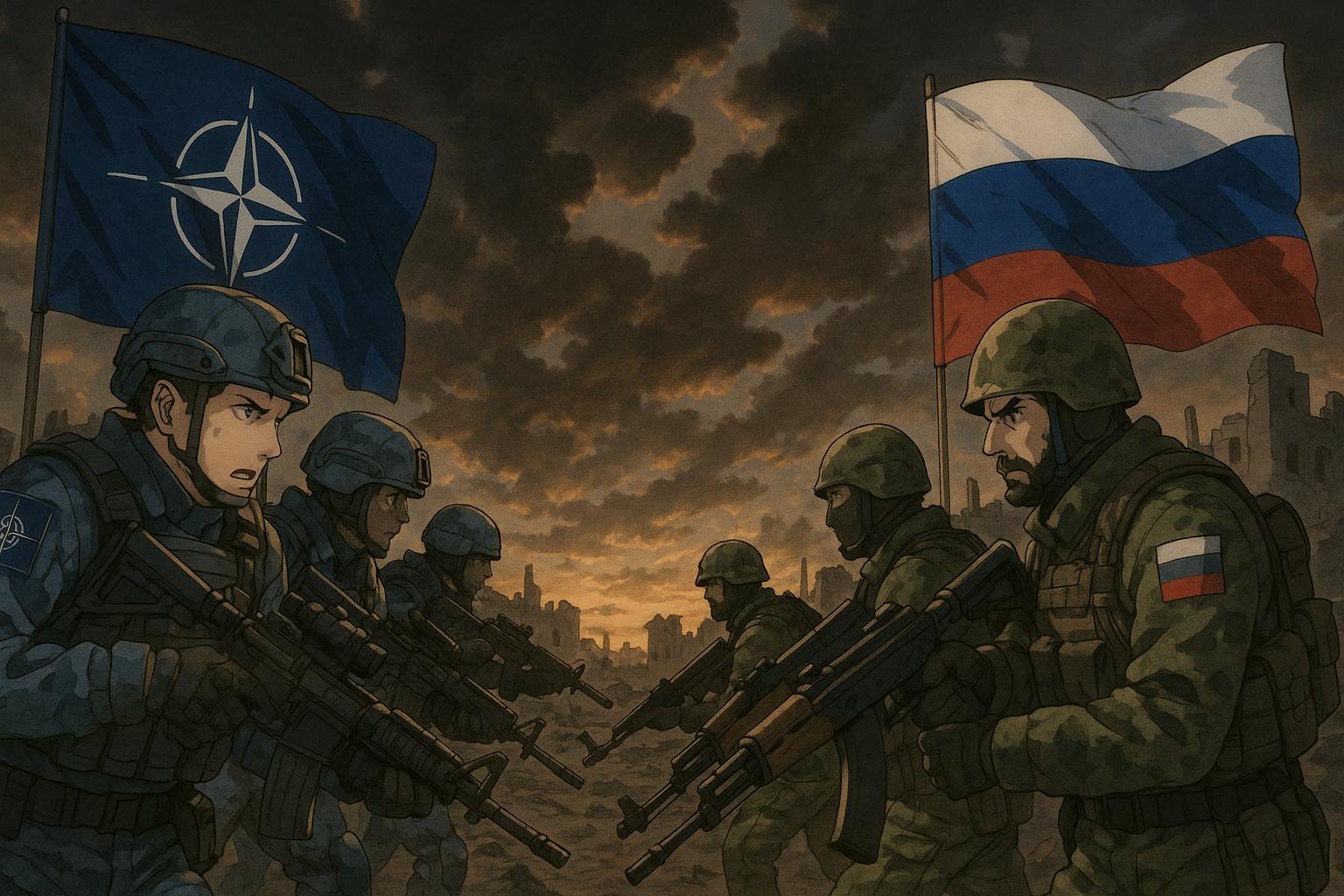New assessments warn that Russia could be positioned to launch an attack on NATO member states by 2027, compelling European nations to rethink their defence strategies as Moscow intensifies its military build-up near western borders.
The spectre of conflict between Russia and NATO looms ever larger, with new assessments suggesting that an attack could occur as early as 2027. According to a report from the International Institute for Strategic Studies, the Russian military may be in a position to challenge NATO’s defences within this timeframe, a situation that raises alarm for member states, particularly in the Baltic region. The report reflects the urgency of the current geopolitical climate, exacerbated by Russia’s ongoing war in Ukraine and increasing international sanctions.
Russia’s offensive in Ukraine has strained both its resources and its military personnel. Yet, despite significant losses, the Russian government appears intent on rebuilding its military capabilities. Evidence of a substantial arms buildup near its western borders, particularly in regions bordering Finland, has intensified concerns that President Vladimir Putin may be gearing up for aggressive actions against NATO member states. A report from the Munich Security Conference underlined this growing anxiety, noting that NATO members are increasingly aware of Russia’s expanding military posture.
In the face of such threats, the comments from Russian Defence Minister Andrei Belousov in late 2024 illustrated a heightened state of alert within Russia. He remarked that the country must prepare for potential conflict, drawing attention to the influence of U.S. military doctrines and decisions emerging from NATO summits as factors necessitating this readiness. This sentiment is echoed by the NATO Secretary General, who has called for European nations to adopt a wartime mindset, advocating for increased defence spending amidst a backdrop of Russia’s rising military expenditure and support from strategic allies such as China, Iran, and North Korea.
Indeed, NATO’s reliance on the United States for military support presents a critical vulnerability. Under the former Trump administration, questions regarding America’s long-term commitment to NATO raised concerns among Western leaders, prompting discussions about the future landscape of European security. The U.S. contributes a significant portion of NATO’s military firepower, including 400 fighter jets and 128,000 troops stationed in Europe, with estimates suggesting that the withdrawal of U.S. forces could cost European nations up to £752 billion over 25 years to replace this capacity.
As nation-states contemplate their own military readiness, there is growing awareness that European allies can no longer presume that the U.S. will consistently provide the necessary support against potential Russian aggression. Highlighting this shift, recent intelligence assessments have indicated that Russia is not only planning for a sustained confrontation but is also restructuring its military for a possible large-scale conventional war, thereby shortening the timeline for potential conflict with NATO.
With tensions escalating and rhetoric intensifying, the path forward remains fraught with peril. NATO countries must navigate a complex security environment while simultaneously confronting the realities of an aggressive Russian state that seems determined to assert its influence on the global stage. As such, the next few years will prove crucial in determining the balance of power in Europe and the enduring viability of NATO’s collective defence.
Reference Map
- Paragraphs 1, 3, 5, 7
- Paragraphs 2, 4, 6
- Paragraphs 1, 5, 7
- Paragraphs 4, 5
- Paragraphs 4, 5
- Paragraph 6
- Paragraph 6
Source: Noah Wire Services
- https://www.express.co.uk/news/world/2055692/putin-nato-attack-world-war-3 – Please view link – unable to able to access data
- https://www.reuters.com/world/europe/putin-accuses-west-pushing-russia-its-red-lines-forcing-it-respond-2024-12-16/ – In December 2024, Russian Defense Minister Andrei Belousov stated that Russia must prepare for a potential conflict with NATO within the next decade. He cited U.S. military doctrines and NATO summit decisions as indicators of this necessity, emphasizing the need for Russia to ensure full readiness for any scenario.
- https://www.ft.com/content/83f8a7e9-dd41-4976-be39-cfd2c9b3a899 – A report from the Munich Security Conference highlighted NATO members’ growing concerns over Russia’s aggressive posture and military capabilities. Despite significant losses in Ukraine, Russia is ramping up defense production and recruiting additional soldiers, leading to fears that it could reconstitute its military forces within five to six years.
- https://apnews.com/article/8a84361c3827081da3f1308851cb19dd – NATO Secretary General Mark Rutte warned of Russia’s intent for a long-term confrontation with Europe. He urged European nations to adopt a wartime mindset and significantly increase defense spending, citing Russia’s rising military expenditure and support from allies like China, Iran, and North Korea.
- https://www.ft.com/content/f268359a-7347-4285-b646-4353f7d6a865 – European leaders at the Munich Security Conference discussed threats from an aggressive Russia and uncertainties from the U.S. under President Trump. The conference emphasized the need for Europe to prepare for potential conflict, with some nations increasing defense spending, while others remain reliant on U.S. support.
- https://kyivindependent.com/isw-economic-military-indicators-suggest-russia-is-preparing-for-large-scale-war-with-nato/ – The Institute for the Study of War (ISW) reported that Russia is preparing for a large-scale conventional conflict with NATO, likely on a shorter timeline than previously anticipated. Indicators include reorganization of its army, troop movements, and missile deployments in the western part of the country.
- https://www.euronews.com/2024/03/21/russia-preparing-for-wider-conflict-with-nato-sooner-than-expected-says-report – Euronews reported that Russia is preparing for a large-scale conventional conflict with NATO, according to the Institute for the Study of War. The analysis suggests that Russia is planning on a shorter timeline than some Western analysts have previously posited, with structural reforms in its military to support both the war in Ukraine and potential future conflict with NATO.
Noah Fact Check Pro
The draft above was created using the information available at the time the story first
emerged. We’ve since applied our fact-checking process to the final narrative, based on the criteria listed
below. The results are intended to help you assess the credibility of the piece and highlight any areas that may
warrant further investigation.
Freshness check
Score:
8
Notes:
The narrative includes recent geopolitical developments and references to ongoing conflicts, suggesting a relatively fresh perspective. However, specific events like the Russian offensive in Ukraine and the Munich Security Conference discussions may have been covered in previous reports.
Quotes check
Score:
5
Notes:
Direct quotes from Russian Defence Minister Andrei Belousov and the NATO Secretary General are mentioned, but no specific sources or dates are provided for these quotes. This limits the ability to verify their original context.
Source reliability
Score:
8
Notes:
The narrative originates from the Express, a generally known publication. While not considered a primary news source for international affairs, it is reputable enough to be considered reliable in terms of factual reporting.
Plausability check
Score:
7
Notes:
The claims about potential conflict are plausible given the current geopolitical tensions and military buildups. However, specific projections like an attack by 2027 are speculative and lack concrete evidence.
Overall assessment
Verdict (FAIL, OPEN, PASS): OPEN
Confidence (LOW, MEDIUM, HIGH): MEDIUM
Summary:
The narrative touches on plausible geopolitical tensions but lacks specific evidence for some claims. The source is generally reliable, but the speculative nature of long-term projections reduces confidence.













